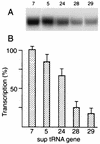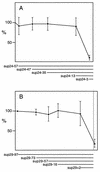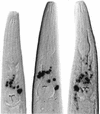Differential expression of individual suppressor tRNA(Trp) gene gene family members in vitro and in vivo in the nematode Caenorhabditis elegans
- PMID: 9447966
- PMCID: PMC108781
- DOI: 10.1128/MCB.18.2.703
Differential expression of individual suppressor tRNA(Trp) gene gene family members in vitro and in vivo in the nematode Caenorhabditis elegans
Abstract
Eight different amber suppressor tRNA (suptRNA) mutations in the nematode Caenorhabditis elegans have been isolated; all are derived from members of the tRNA(Trp) gene family (K. Kondo, B. Makovec, R. H. Waterston, and J. Hodgkin, J. Mol. Biol. 215:7-19, 1990). Genetic assays of suppressor activity suggested that individual tRNA genes were differentially expressed, probably in a tissue- or developmental stage-specific manner. We have now examined the expression of representative members of this gene family both in vitro, using transcription in embryonic cell extracts, and in vivo, by assaying suppression of an amber-mutated lacZ reporter gene in animals carrying different suptRNA mutations. Individual wild-type tRNA(Trp) genes and their amber-suppressing counterparts appear to be transcribed and processed identically in vitro, suggesting that the behavior of suptRNAs should reflect wild-type tRNA expression. The levels of transcription of different suptRNA genes closely parallel the extent of genetic suppression in vivo. The results suggest that differential expression of tRNA genes is most likely at the transcriptional rather than the posttranscriptional level and that 5' flanking sequences play a role in vitro, and probably in vivo as well. Using suppression of a lacZ(Am) reporter gene as a more direct assay of suptRNA activity in individual cell types, we have again observed differential expression which correlates with genetic and in vitro transcription results. This provides a model system to more extensively study the basis for differential expression of this tRNA gene family.
Figures






Similar articles
-
Genetic and molecular analysis of eight tRNA(Trp) amber suppressors in Caenorhabditis elegans.J Mol Biol. 1990 Sep 5;215(1):7-19. doi: 10.1016/S0022-2836(05)80090-7. J Mol Biol. 1990. PMID: 2398498
-
Differential expression of five tRNA(UAGTrp) amber suppressors in Caenorhabditis elegans.Mol Cell Biol. 1988 Sep;8(9):3627-35. doi: 10.1128/mcb.8.9.3627-3635.1988. Mol Cell Biol. 1988. PMID: 3221861 Free PMC article.
-
Expression of a Drosophila melanogaster amber suppressor tRNA(Ser) in Caenorhabditis elegans.Mol Gen Genet. 1993 Oct;241(1-2):26-32. doi: 10.1007/BF00280197. Mol Gen Genet. 1993. PMID: 8232208
-
Identity of Saccharomyces cerevisiae tRNA(Trp) is not changed by an anticodon mutation that creates an amber suppressor.J Biol Chem. 1993 Jan 5;268(1):217-20. J Biol Chem. 1993. PMID: 8416930
-
Nonsense suppression in Dictyostelium discoideum.Dev Genet. 1990;11(5-6):410-7. doi: 10.1002/dvg.1020110514. Dev Genet. 1990. PMID: 2096017
Cited by
-
Analysis of Stop Codons within Prokaryotic Protein-Coding Genes Suggests Frequent Readthrough Events.Int J Mol Sci. 2021 Feb 14;22(4):1876. doi: 10.3390/ijms22041876. Int J Mol Sci. 2021. PMID: 33672790 Free PMC article.
-
Therapeutic promise of engineered nonsense suppressor tRNAs.Wiley Interdiscip Rev RNA. 2021 Jul;12(4):e1641. doi: 10.1002/wrna.1641. Epub 2021 Feb 10. Wiley Interdiscip Rev RNA. 2021. PMID: 33567469 Free PMC article. Review.
-
Expanding the genetic code of an animal.J Am Chem Soc. 2011 Sep 14;133(36):14196-9. doi: 10.1021/ja2054034. Epub 2011 Aug 22. J Am Chem Soc. 2011. PMID: 21819153 Free PMC article.
-
Uncoupling the pleiotropic phenotypes of clk-1 with tRNA missense suppressors in Caenorhabditis elegans.Mol Cell Biol. 2006 May;26(10):3976-85. doi: 10.1128/MCB.26.10.3976-3985.2006. Mol Cell Biol. 2006. PMID: 16648490 Free PMC article.
-
Tissue- and Time-Specific Expression of Otherwise Identical tRNA Genes.PLoS Genet. 2016 Aug 25;12(8):e1006264. doi: 10.1371/journal.pgen.1006264. eCollection 2016 Aug. PLoS Genet. 2016. PMID: 27560950 Free PMC article.
References
-
- Candelas G C, Arroyo G, Carrasco C, Dompensciel R. Spider silkglands contain a tissue-specific alanine tRNA that accumulates in vitro in response to the stimulus for silk protein synthesis. Dev Biol. 1990;140:215–220. - PubMed
-
- Deng W P, Nickoloff J A. Site-directed mutagenesis of virtually any plasmid by eliminating a unique site. Anal Biochem. 1992;200:81–88. - PubMed
-
- Dingermann T, Amon-Bohm E, Bertling W, Marschalek R, Nerke K. A family of non-allelic tRNAGUUVal genes from the cellular slime mold Dictyostelium discoideum. Gene. 1988;73:373–384. - PubMed
Publication types
MeSH terms
Substances
LinkOut - more resources
Full Text Sources
Other Literature Sources
